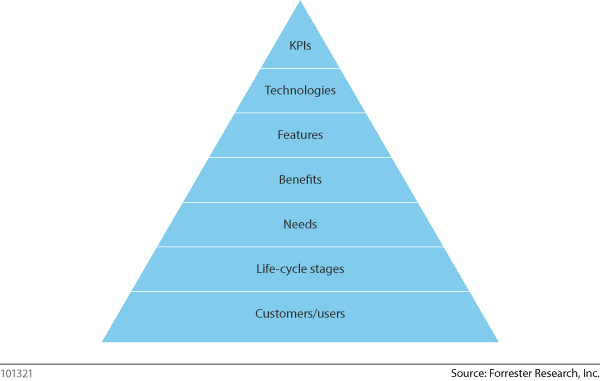Seven Steps To A Needs-Based Marketing Strategy
Brands deals with human needs and wants. Leo Burnett, the advertising executive, said: “The work of an advertising agency is warmly and immediately human. It deals with human needs, wants, dreams, and hopes.” Smart brands know not to initially focus on what they have to sell but rather on how it meets consumers’ needs. If you can address a strong consumer need, you will get those consumers to act. If you can get them to act, then you have opened an all-important channel of dialogue.
The fulfillment of consumer needs, however, is not always a linear hierarchic approach as proposed by Maslow and effectively debunked by Forrester analyst James McQuivey in his book Digital Disruption. Human needs take place simultaneously and are fueled by a mix of short- and long-term motivations — some conscious and some unconscious. As a student, I would sometimes forgo food on a Friday so I could afford to go to a concert that night; or consider a Spanish couple postponing the short-term comfort of a much-needed upgrade to their central heating so they can put their child through the next year of college.
The pyramid diagram below shows how the foundation of this needs-based thinking is built from the ground up, from customer descriptions through to the technology and KPIs applied.

In a world chock full of emerging technology and innovation, it’s easy to have your attention diverted by the latest wonder. Focusing on consumer needs is a healthy first principle that will engender success and avoid technology-led strategies. Twitter founder Ev Williams made the point at the recent XOXO conference: “Those who lose sight of basic human needs — who want to give people the next great idea — will have problems.”
My new report, Seven Steps to a Needs Based Marketing Strategy, looks at strategies based on customer needs. It suggests replacing the concept that brand strategies are driven by how marketers can meet their own objectives with the idea that consumers’ needs must drive the approach. A consumer-led, needs-based approach to marketing strategy benefits brands in the following ways:
• It unites product and marketing strategy. The distinctions between product, service, and marketing continue to blur as organizations galvanize themselves to provide complete brand experiences for customers. This “macro brand experience” is the aggregate of all the hardware and software experiences relayed through physical products, apps, social networking, and TV and video content through to interactions with sales staff and a myriad of other touchpoints. Isolating the product or the marketing strategy ultimately does not serve the customer well. It’s not a question of viewing marketing programs as an extension of the product or the product as an extension of the marketing programs — it’s about having a common, complementary approach focused on holistic engagement with the customer. That common thread is anticipating and meeting customers’ needs.
• It forces you to constantly reappraise the market you are in. Often, ideas generated from inside your company can bring years of bias about the business that you are or should be in. However, the thing that consumers need next can be very incremental or discontinuous and therefore far from your core business. To really address a constellation of needs can lead you into new markets and technologies quicker than may be comfortable for you. The digital agency AKQA worked with automotive brand Fiat in a rapid and Agile manner, driven by innovating around telemetrics black-box data from the Fiat 500 series vehicles. The resulting Eco Index project began as a method to highlight fuel efficiencies for consumers in order to provide them the benefit of becoming better drivers and blossomed into a much wider service by fulfilling adjacent needs using apps, social experiences, and B2B offerings. Customers’ immediate and adjacent needs must drive the business that you are in.
• It ensures you avoid technology-led approaches. There will always be a new technology trinket on the horizon that some in your organization will say needs a strategy — we’ve all heard the question, “What is your mobile strategy?” or worse, “What’s your strategy for Vine?” No technology ever needs a strategy — instead, technologies must fulfill strategies. Whether you’re working in innovation teams, operations, or business technology, ensure that you’re able to answer the question, “What need does this meet, and how does it benefit the customer?”
• It supports the emerging utility-centric marketing approach. Consumers have more and more data to consider — increasingly pushed approaches amplify noise and are contextually irrelevant. Providing solutions and meeting needs for consumers best suits a pull-based approach: Customers call on you when they need you. As a follow-up to its support during Hurricane Sandy, AT&T is partnering with Goal Zero to deploy Street Charge stations in numerous locations around New York, providing consumers with free recharges from branded solar powered stations. Meeting consumer needs often creates a shorter path to loyalty and increased minutes of engagement.
Do you agree? Have you moved over to a needs-based approach? Take a minute to look at the marketing features you are developing for customers and apply the seven steps process retrospectively — does your rationale hold water? I’d love to hear what you think.